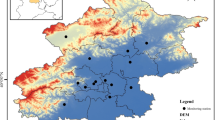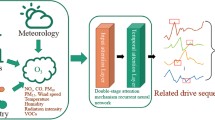Abstract
Surface ozone (\(O_3\)) pollution is a serious environmental problem that endangers human health, and it is also an increasingly prominent environmental problem in the World. Existing works focus on how to directly improve the accuracy of predicting the target sequence from the input sequence while ignoring the inherent uncertainty of ozone in the atmosphere during the modeling process. Therefore, we utilize data fusion techniques to integrate ground observation data, satellite data, and reanalysis data for simulating atmospheric dynamics and enhancing prediction accuracy. We developed a sequence to sequence using a unit embedded with spatiotemporal information self attention mechanism as its encoder (OzoneNet) predict ozone concentration in the future. In the proposed method, we utilize the LSTM model with Spatiotemporal information self-attention mechanism to extract fixed Spatiotemporal data features, and the temporal dimension characteristics in long-term series are modeled by sequence-to-sequence network. Results show that the model has higher reliability and validity, outperforming benchmark models in simulating future changes in \(O_3\) concentrations. The progeress of this method can help the public take corresponding protective measures, provide scientific guidance for the government’s coordinated control of regional pollution, and can also provide important references for environmental protection and climate change research







Similar content being viewed by others
Availability of data and materials
The National City Air Quality Real-time Publishing Platform (https://air.cnemc.cn:18007/); European Centre for Medium-Range Weather Forecasts(ECMWF) (https://www.ecmwf.int/en/forecasts/dataset/ecmwf-reanalysis-v5); Himawari-8 (https://www.eorc.jaxa.jp/ptree/).
References
Armstrong MP, Marciano R (1994) Inverse-distance-weighted spatial interpolation using parallel supercomputers. Photogram Eng Remote Sens 60(9):1097–1102
Bhattacharya S, Shahnawaz S (2021) Using machine learning to predict air quality index in new delhi. arXiv:2112.05753
Chang JH, Griffith SM, Lin NH (2022) Impacts of land-surface forcing on local meteorology and ozone concentrations in a heavily industrialized coastal urban area. Urban Climate 45:101257
Chattopadhyay G, Midya SK, Chattopadhyay S (2019) Mlp based predictive model for surface ozone concentration over an urban area in the gangetic west bengal during pre-monsoon season. J Atmospheric Solar-Terrestrial Phys 184:57–62
Chen D, Zhao N, Lang J, Zhou Y, Wang X, Li Y, Zhao Y, Guo X (2018) Contribution of ship emissions to the concentration of pm2. 5: A comprehensive study using ais data and wrf/chem model in bohai rim region, china. Sci Total Environ 610:1476–1486
Chen S, Wang H, Lu K, Zeng L, Hu M, Zhang Y (2020) The trend of surface ozone in beijing from 2013 to 2019: Indications of the persisting strong atmospheric oxidation capacity. Atmospheric Env 242:117801
Chen Y, Chen X, Xu A, Sun Q, Peng X (2022) A hybrid cnn-transformer model for ozone concentration prediction. Air Quality, Atmosphere & Health 15(9):1533–1546
Chuang MT, Zhang Y, Kang D (2011) Application of wrf/chem-madrid for real-time air quality forecasting over the southeastern united states. Atmospheric Environ 45(34):6241–6250
Fan Y, Ding X, Hang J, Ge J (2020) Characteristics of urban air pollution in different regions of china between 2015 and 2019. Building Env 180:107048
Faruck M, Chatterjee P (2018) Air pollution detection using multisensor data fusion. In: Proceedings of the workshop program of the 19th international conference on distributed computing and networking, pages 1–2
He J, Gong S, Yu Y, Yu L, Wu L, Mao H, Song C, Zhao S, Liu H, Li X et al (2017) Air pollution characteristics and their relation to meteorological conditions during 2014–2015 in major chinese cities. Environ Pollut 223:484–496
Huang X, Yi M, Deng S, Zhao Q, Chen J (2023) The characteristics of daily solar irradiance variability and its relation to ozone in hefei, china. Air Quality, Atmosphere & Health 16(2):277–288
Kocak Y, Koklu M (2022) Multi-layer long short-term memory (lstm) prediction model on air pollution for konya province. Int J Appl Math Electron Comput 10(4):93–100
Li K, Jacob DJ, Liao H, Shen L, Zhang Q, Bates KH (2019) Anthropogenic drivers of 2013–2017 trends in summer surface ozone in china. Proceed National Academy Sci 116(2):422–427
Li S, Chen L, Huang G, Lin J, Yan Y, Ni R, Huo Y, Wang J, Liu M, Weng H, Wang Y (2020) Retrieval of surface pm2. 5 mass concentrations over north china using visibility measurements and geos-chem simulations. Atmospheric Environ 222:117121
Lightstone SD, Moshary F, Gross B (2017) Comparing cmaq forecasts with a neural network forecast model for pm2. 5 in new york. Atmosphere 8(9):161
Lindemann B, Müller T, Vietz H, Jazdi N, Weyrich M (2021) A survey on long short-term memory networks for time series prediction. Procedia CIRP 99:650–655
Lu X, Hong J, Zhang L, Cooper OR, Schultz MG, Xu X, Wang T, Gao M, Zhao Y, Zhang Y (2018) Severe surface ozone pollution in china: a global perspective. Environ Sci & Technol Lett 5(8):487–494
Maji KJ, Ye WF, Arora M, Nagendra SS (2019) Ozone pollution in chinese cities: Assessment of seasonal variation, health effects and economic burden. Env Pollut 247:792–801
Mao W, Jiao L, Wang W (2022) Long time series ozone prediction in china: A novel dynamic spatiotemporal deep learning approach. Build Environ 218:109087
Mishra M, Chen PH, Bisquera W Jr, Lin GY, Le TC, Dejchanchaiwong R, Tekasakul P, Jhang CW, Wu CJ, Tsai CJ (2023) Source-apportionment and spatial distribution analysis of vocs and their role in ozone formation using machine learning in central-west taiwan. Environ Res 232:116329
Mnih V, Heess N, Graves A et al (2014) Recurrent models of visual attention. Adv Neural Inf Process Syst 27
Mueller SF, Mallard JW (2011) Contributions of natural emissions to ozone and pm2. 5 as simulated by the community multiscale air quality (cmaq) model. Environ Sci & Technol 45(11):4817–4823
Muljana R, Ayuningtyas LD, Daksa RP, Djamhari SF, Fiezayyan MA, Sagala NT (2023) Air pollution prediction using random forest classifier: A case study of dki jakarta. In: 2023 International conference on computer science, information technology and engineering (ICCoSITE), IEEE, pp 428–433
Nababan AA, Zarlis M, Nababan EB et al (2022) Air quality prediction based on air pollution emissions in the city environment using xgboost with smote. In: 2022 IEEE International conference of computer science and information technology (ICOSNIKOM), IEEE, pp 1–6
Segal MR (2004) Machine learning benchmarks and random forest regression
Seinfeld JH, Pandis SN (1998) Atmospheric chemistry and physics: from air pollution to climate change. Environ: Sci Policy Sustainable Develop 40(7):26–26
Sutskever I, Vinyals O, Le QV (2014) Sequence to sequence learning with neural networks. Adv Neural Inf Process Syst 27
Vaswani A, Shazeer N, Parmar N, Uszkoreit J, Jones L, Gomez AN, Kaiser Ł, Polosukhin I (2017) Attention is all you need. Adv Neural Inf Process Syst 30
Wang T, Xue L, Brimblecombe P, Lam YF, Li L, Zhang L (2017) Ozone pollution in china: A review of concentrations, meteorological influences, chemical precursors, and effects. Sci Total Environ 575:1582–1596
Wang P, Qiao X, Zhang H (2020) Modeling pm2. 5 and o3 with aerosol feedbacks using wrf/chem over the sichuan basin, southwestern china. Chemosphere 254:126735
Woody MC, Wong HW, West JJ, Arunachalam S (2016) Multiscale predictions of aviation-attributable pm2. 5 for us airports modeled using cmaq with plume-in-grid and an aircraft-specific 1-d emission model. Atmospheric Environ 147:384–394
Zhang J, Li S (2022) Air quality index forecast in beijing based on cnn-lstm multi-model. Chemosphere 308:136180
Zhou H, Wang T, Zhao H, Wang Z (2022) Updated prediction of air quality based on kalman-attention-lstm network. Sustainability 15(1):356
Zou X, Zhao J, Zhao D, Sun B, He Y, Fuentes S (2021) Air quality prediction based on a spatiotemporal attention mechanism. Mobile Inf Syst 2021:1–12
Funding
This research was supported by the National Natural Science Foundation of China(41975131, 42075138 and 42375147).
Author information
Authors and Affiliations
Corresponding author
Ethics declarations
Competing interests
The authors declare no competing interests.
Ethics approval
The authors have no competing interests to declare that are relevant to the content of this article.
Consent to participate
Not applicable
Consent for publication
Not applicable
Additional information
Publisher's Note
Springer Nature remains neutral with regard to jurisdictional claims in published maps and institutional affiliations.
Rights and permissions
Springer Nature or its licensor (e.g. a society or other partner) holds exclusive rights to this article under a publishing agreement with the author(s) or other rightsholder(s); author self-archiving of the accepted manuscript version of this article is solely governed by the terms of such publishing agreement and applicable law.
About this article
Cite this article
Tian, W., Ge, Z. & He, J. OzoneNet:A spatiotemporal information attention encoder model for ozone concentrations prediction with multi-source data. Air Qual Atmos Health (2024). https://doi.org/10.1007/s11869-024-01568-5
Received:
Accepted:
Published:
DOI: https://doi.org/10.1007/s11869-024-01568-5




